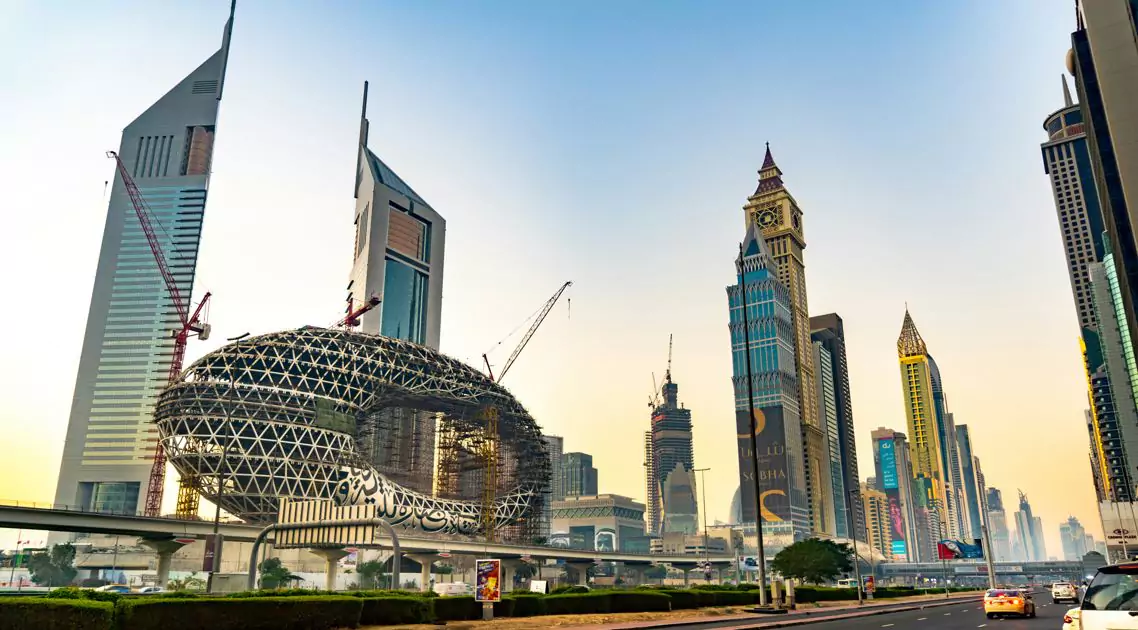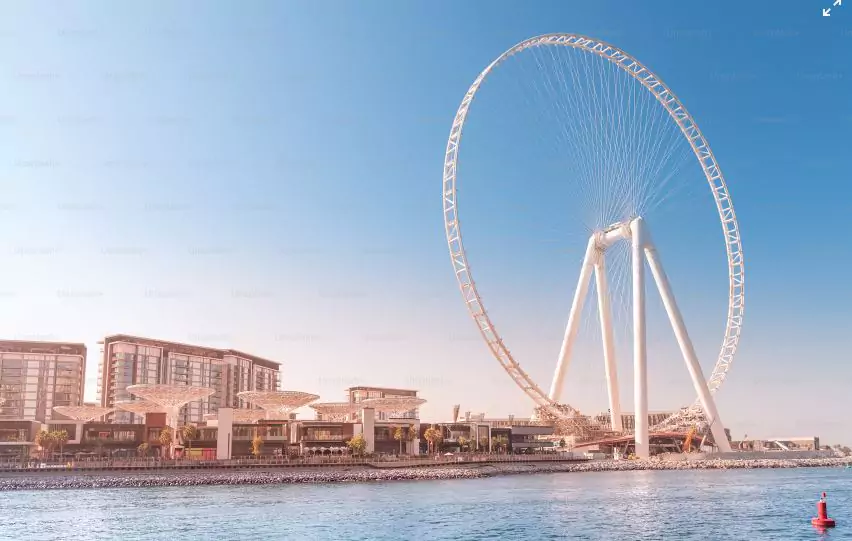Dubai (city) | Geography, Map, & History |


 +34
+34
One of the richest of the seven emirates that make up the United Arab Emirates federation—which was established in 1971 after gaining independence from Great Britain—is Dubai, the capital and largest city of the emirate of Dubai. The origin of the name Dubai is the subject of various theories. Some believe it alludes to a market that used to be close to the city, while others identify it with the daba, a kind of locust that is prevalent in the area. Dubai is frequently considered the best business destination in the Middle East and has been compared to Singapore and Hong Kong in recent years. 13.5 square miles, or 35 square kilometers. Est. population 2017: 2,919,178.
Character of the city
Dubai is a city of skyscrapers, beaches, and ports where major corporations coexist with sun-loving tourists. Its sizable expat community gives it the feel of a Middle Eastern melting pot, and the general climate is one of tolerance. In the city, religious affiliations are not very important. Although churches and Hindu temples coexist with Dubai's mosques, the majority faith is Islam.
Dubai is a comparatively crime-free city with remarkable growth fostered by openness to commerce and administrative efficiency. Nonetheless, there is still covert corruption prevalent and criticism of Dubai's autocratic government and ruling class is not accepted.
Landscape
Small sections of sand beaches in Dubai's western region are advantageous and have boosted the city's tourism sector. The leadership of Dubai have worked to expand the city's few seafronts, and given the lack of any offshore natural islands, they have encouraged developers to build enormous artificial islands off the city's coast. The most well-known of these is Palm Jumeirah, fashioned like a palm tree. Among the others are the "World" islands, a collection of tiny islands that, when viewed from above, resemble a map of the world.
City site and layout
Dubai is located on the southern coasts of the Persian Gulf, straddling Dubai Creek, a natural inlet. Due to the early city's emphasis on fishing, pearl diving, and marine trade, the region served as Dubai's center for more than a century. The oldest buildings in Dubai line the creek; they are mostly 1960s construction, never rising higher than two stories. Some much earlier structures have been renovated in the Bastakiyyah area on the western shore of the creek; many of these have the characteristic wind tower design that was brought here in the early 20th century by Persian merchants.
Sheikh Zayed Road is lined with a row of buildings that make up the new city center. Among these are the Emirates Towers, which were constructed in the late 1990s and early 2000s and contain government buildings and a hotel. Near Sheikh Zayed Road are the Burj Khalifa, the world's tallest structure at the time of its official opening in 2010, and the Dubai International Financial Centre, housed in a futuristic arch-shaped edifice;
It bears the name Khalifa ibn Zayed Al Nahyan, the emir of Abu Dhabi and president of the United Arab Emirates. There are various wealthy communities to the west of the skyscrapers, the majority of which are home to large villas. The Burj al-ʿArab, a massive sail-shaped structure housing a premium hotel, is located on their outskirts. Newer skyscraper complexes are situated further west, encircling multiple man-made lakes and a marina.

Climate
Like a large portion of the Persian Gulf coast, Dubai experiences year-round heat. Throughout the year, humidity is moderate during the winter and high during the summer. With lows of roughly 15 °C (49 °F), January is typically the coldest winter month, and July is typically the hottest summer month with highs of more than 40 °C (104 °F).
People
Over the course of the last two centuries, Dubai's population has increased steadily from a few thousand native residents to well over two million. The majority of the early population growth was caused by merchants from nearby nations moving to Dubai because of its welcoming business environment. Due to the city's construction boom in the later half of the 20th century, South Asian laborers and skilled foreigners from all over the world became much more numerous and influential in Dubai's multisector economy. In the city, foreigners outweigh local Emiratis by a wide margin.
Foreigners of different nations are dispersed throughout Dubai, with the exception of the laborers, who are kept in work camps outside the city limits. In actuality, English is the lingua franca even though Arabic is the official language. Although there are sizable groups of Christians, Hindus, and Sikhs, the majority of the native people and expatriates are Muslims. The many communities live in harmony because of the ruling family's tolerance of non-Muslims and the city's emphasis on business, yet there have been instances where foreign residents have disregarded drug and decency laws.
Economy of Dubai
It is a myth that Dubai's economy is centered around oil. It utilized the little oil income it did have between the 1960s and the 1990s to construct physical infrastructure in order to improve other areas of its economy. Since Dubai is home to two of the biggest ports in the world and a major hub for international air freight, trade continues to be the main driver of the city's economy. In an effort to draw in industrial investment, the Jebel Ali free-trade zone was created in the 1980s. Industries that have their headquarters there include cement, automobile manufacturing, and aluminum smelting.

Finance and other services
The 21st century has seen a rise in initiatives aimed at luring in foreign capital. There are now a number of free zones, such as Jebel Ali, that let foreign businesses operate out of Dubai without requiring a local partner. These have been incredibly successful; the biggest is home to almost 6,400 businesses, many of which are from North America or Europe. The city started marketing itself as a high-end vacation spot in the 1990s, devoting a sizeable portion of its GDP to opulent resorts and activities.
By 1998 Dubai had begun to permit foreign investors to purchase 99-year leases on properties, allowing the real estate sector to flourish. The Dubai International Financial Centre, which opened in 2006, is set aside in the UAE constitution as an independent legal jurisdiction; it operates under a separate commercial and civil framework based on English common law. This arrangement caters to international financial companies seeking to establish a presence in the Middle East.
The real estate and financial sectors collapsed in 2009 following the global credit crisis, but Abu Dhabi's $10 billion loan prevented Dubai from going into default and the real estate market quickly rebounded. These companies can use Dubai's geographic location as a way to bridge the time zones between major financial hubs in Europe and East Asia.
Transportation
With wide highways, a hot climate, and a year-round reliance on air-conditioning, Dubai is not a welcoming city for pedestrians, so vehicle traffic can be extremely intense. However, in the early 21st century, new bridges, roads, and a fully automated, driverless metro rail system have eased the frustrations of moving around the city. Tourism has been greatly enhanced by the Dubai-owned airline, Emirates, which operates a large and modern fleet of aircraft.
Administration and society
Government
One of the biggest government agencies in the nation is the Dubai Municipality. Under the leadership of a member of the royal family, the chairman of Dubai Municipality is the person to whom the director general reports. The 34 divisions and six sectors under the director general's direction employ roughly 11,000 individuals. In addition to overseeing city services, the municipality plays a significant role in the emirate's economic expansion.
Municipal services
Although some services, including rubbish collection, have been criticized for lagging behind, Dubai's water and energy supplies have mainly kept up with the city's population increase. Public areas and parks have been constructed and maintained to a high standard; in the 2010s, the city significantly increased the quantity of green spaces.
Health
With multiple private facilities, such as the American Hospital Dubai, Dubai offers typically excellent health care to its citizens who have private medical insurance. The government runs several more hospitals for people without insurance.
Education
Public and private sectors are separated in the area of education. Arabic is typically taught in public schools, however English is taught in the majority of private institutions and all colleges. There are two well-known universities in the area: Zayed University (1998) and the American University in Dubai (1995). The majority of the employees are foreign nationals, with a sizable percentage coming from North America.
Cultural life
Dubai's film and art sectors flourished in the early 21st century, with the Dubai International Film Festival promoting both domestic and foreign films and the yearly Art Dubai expo exhibiting modern art. Housed in a fortification from the eighteenth century, the Dubai Museum features exhibits and artifacts pertaining to the prehistoric and traditional history of the region. The city of Dubai is home to multiple branches of the public library system, while its shopping malls have numerous booksellers.
There are numerous international athletic events held in Dubai. These have significantly improved its standing as a travel destination. The most lucrative horse race in the world is the Dubai World Cup, and the European Professional Golfers' Association (PGA) Tour frequently visits the city for the Dubai Desert Classic.
The media landscape in the city is still largely split between foreign media companies operating branch offices out of Dubai Media City, an intentionally constructed complex that acts as a regional hub for international media, and government-backed television and newspapers, the majority of which are heavily censored. These latter include the Associated Press and the BBC, whose publications are exempt from regional limitations.
History
The city expanded quickly as it developed into a significant hub for the pearl-diving business from its modest origins as a little fishing village that was first mentioned in records in the 18th century. The city continued to grow in the early 20th century and quickly developed into a hub for re-exporting goods from Persia and India thanks to the business-savvy royal family's reduction of taxes and embracing of foreign traders. Dubai, which benefited from a moderate oil riches in the second half of the 20th century, kept its focus on trade and investment, directing oil surpluses toward large-scale infrastructure projects including a trade center, dry docks, and an international airport. The city started to diversify in the 1990s, expanding its real estate, finance, and luxury tourism industries.
All of these needed educated, skilled foreign labor, and many came to Dubai because of its stable political environment and tax-free wages. The city has a reputation for having one of the more open communities in the area and took on a very cosmopolitan air due to the influx of expats from Asia, Europe, and North America, in addition to other parts of the Arab world.
I actually found the place by luck, I didn’t ask anyone for directions,